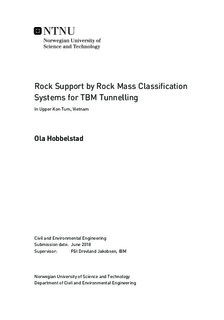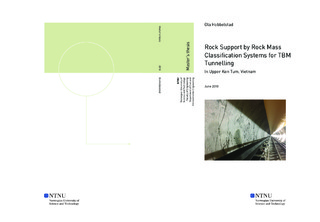| dc.description.abstract | The purpose of this thesis is to study the difference in the use of rock support measures in
tunnels excavated by different methods. The methods examined are excavation by Tunnel
Boring Machine (TBM) and excavation by drill and blast. The aim of the study has been to
address whether the smooth contour that excavation by TBM provides, leads to reduced
amounts of rock support.
Field work has been carried out to examine the possible relation between the method of
excavation and rock support requirements. The field work was conducted at Upper Kon Tum
Hydroelectric Power Project (HPP) in Vietnam. Here has 650 meters of a headrace tunnel,
excavated by TBM, been geologically mapped. At the outlet of the headrace tunnel, a short
portal tunnel was excavated by drill and blast. 105 meters of this portal tunnel was also mapped
to be able to compare the need for rock support in the two types of tunnels.
The mapped rock mass has been classified according to established rock mass classification
systems. The Rock Quality Index (Q-system) and the Rock Mass Rating (RMR-system) has
been used for this purpose. Estimations of both type and quantity of rock support based on the
classification systems are given, and has been compared to already installed rock support in the
tunnels. In addition, estimations regarding costs of rock support has been done.
In total 755 meters of the tunnel at Upper Kon Tum HPP were mapped with respect to geology.
The rock mass is characterized as hard and competent, and it is regularly intersected by zones
of weakness. The collected data basis consists mainly of rock mass in the classes of fair to
extremely good quality, according to the Q-system, and the rock mass classes I and II, according
to the RMR-system.
For rock mass of quality between fair and extremely good, it has been found that only rock
bolting is necessary as rock support. The need for rock bolting is reduced by a number of 266
rock bolts when the tunnel is excavated by TBM compared to drill and blast. 555 meters of the
headrace tunnel, was within these rock mass classes. The reduced number of bolts corresponds
to a saving of around 360 NOK per meter tunnel excavated.
The conclusive remarks are that the amount of rock support is reduced in tunnels excavated by
tunnel boring machines compared to tunnels excavated by drill and blast in the form of rock
bolts. For other kinds of rock support, no relation to the method of excavation has been found.
However, the basis of data is not strong enough to make up a final conclusion on this matter. It
is, nevertheless, likely that further studies will be able to confirm this indication. | |

